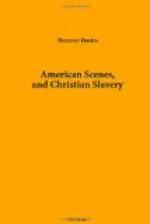LETTER XXXI.
The Spot on which Whitfield preached—Judge Daggett—Governor Yale —Yale College—The Libraries—Elliot’s Indian Bible—Geological Museum—Dr. Goodrich—Education and Expenses at Yale College—The Graves of the Regicides.
Before I take you to “Yale,” let me show you the spot on the Green on which, in 1745, Whitfield, being refused admission to the Congregational church, preached in the open air, under a tree, to an immense congregation,—so great at that time was the dislike to a fervid evangelical ministry. But more than a century has rolled away; and how changed is the scene!
But, observe you that feeble, tottering old gentleman coming along the avenue? It is the Hon. David Daggett, LL.D., late Chief Justice of the Supreme Court of Connecticut. He is a member, and, I believe, a deacon of one of the Congregational churches in this city. Twelve or thirteen years ago that very man, sitting on the judicial bench, condemned Miss Randall to be punished for—teaching a coloured child to read!
Now for Yale. The Rev. Samuel W. S. Dutton, the minister of the North Church, will accompany us. This institution was founded in the year 1700. It derived its name from the Hon. Elihu Yale, a gentleman, I am proud to say, descended from an ancient and respectable family in Wales. His father, Thomas Yale, Esq., came over with the first settlers of New Haven. His son Elihu went to England at ten years of age, and to the East Indies at thirty. In the latter country he resided about twenty years, was made Governor of Madras, acquired a large fortune, returned to England, was chosen Governor of the East India Company, and died at Wrexham in Denbighshire in 1721. On several occasions he made munificent donations to the new institution during the years of its infancy and weakness, on account of which the trustees by a solemn act named it “Yale College.”
The college buildings—which, like Rome, were not all erected in a day—consist of four plain spacious edifices, built of brick, each four stories high, and presenting a front, including passage-ways, of about 600 feet. That neat white house on your right, as you stand before these buildings, is the President’s dwelling—the very house in which resided Dr. Timothy Dwight. But you are not looking at it. Ah! I see your attention is attracted by that student sitting on the sill of the open window of his study, having in his hand a book, and in his mouth a pipe of clay; by which, with the aid of fire, he is reducing a certain tropical weed into its original chemical elements. Perhaps you think that rather undignified; and so it is. I wish you had not seen it; but worse is done at Oxford and Cambridge.




